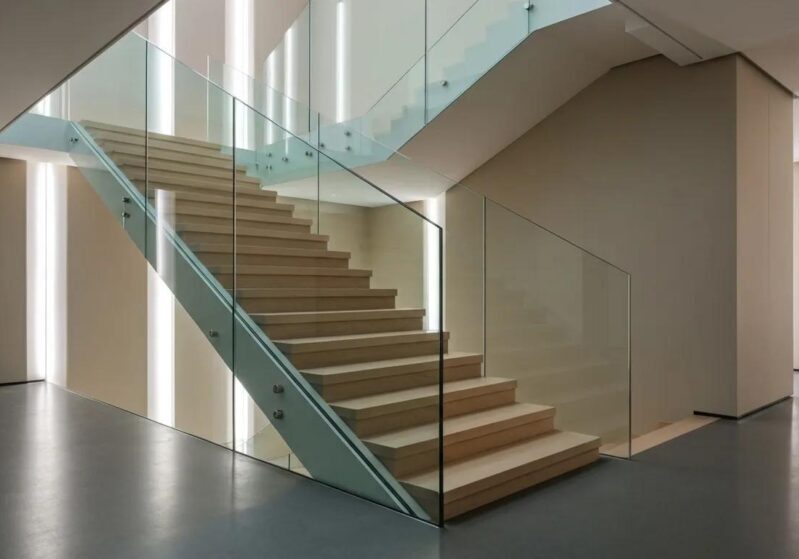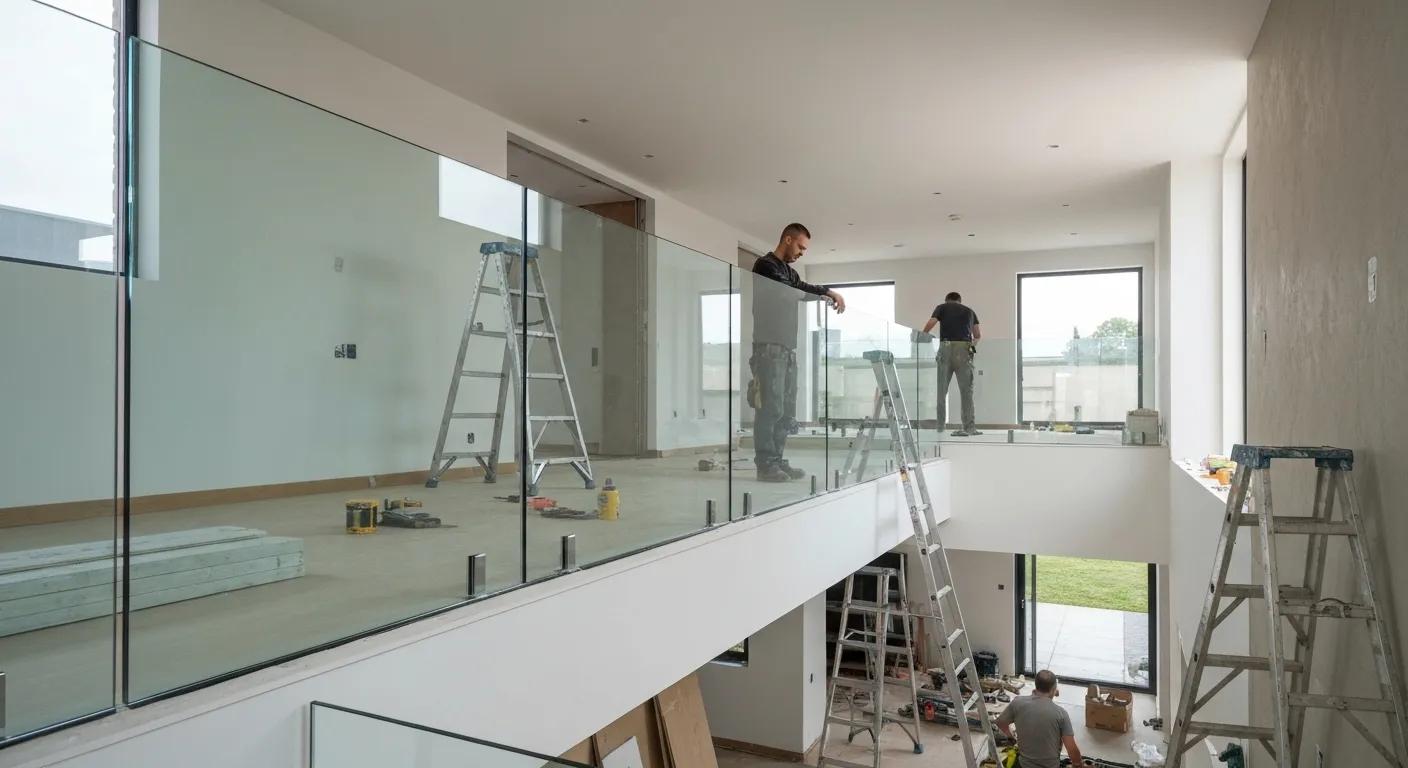
Understanding Compliance Standards for Residential Glass Railings in Canada
Navigating residential glass railing compliance can feel overwhelming for homeowners and contractors alike. This guide delivers clear, actionable Canadian building code requirements for indoor glass railings, covering key regulations, dimension standards, safety glazing protocols, structural loads, installation best practices, and permitting plus maintenance steps. You will learn how the National Building Code of Canada (NBC) and provincial codes govern guardrail assemblies, the minimum height, thickness, spacing thresholds required for safety, glazing specifications under CAN/CGSB and CSA standards, load capacity benchmarks, and the pathway to secure permits and sustain long-term compliance.
What Are the Key Building Codes Governing Residential Glass Railings in Canada?
Residential glass railings in Canada must comply with multiple model codes and provincial adaptations that define height, glass type, structural loads and safety glazing protocols. The primary regulations include:
- National Building Code of Canada (NBC) as the baseline model for all provinces.
- Ontario Building Code (OBC) for Ontario-specific amendments and requirements.
- Quebec Construction Code (QCC) translating NBC provisions into French-language standards.
- British Columbia Building Code (BCBC) integrating NBC rules with region-specific seismic considerations.
These codes ensure consistent safety and structural performance across Canadian homes, and introducing the specific requirements for each lays the foundation for detailed dimension, glazing and load standards.
How Does the National Building Code of Canada (NBC) Regulate Glass Railings?
The National Building Code of Canada establishes minimum guardrail height, load resistance and glazing safety provisions for all residential railings. Under NBC Section 3.4.2, guardrails must:
- Reach a minimum height of 1070 mm on decks and balconies.
- Withstand a uniform load of 0.75 kN/m and a point load of 1.0 kN without permanent deflection.
- Use safety glazing compliant with CAN/CGSB 12.1-M or laminated assemblies where structural integrity is crucial.
National Building Code of Canada Requirements
The National Building Code of Canada (NBC) sets the baseline standards for guardrail height, load resistance, and glazing safety provisions for all residential railings across the country. These mandates are the foundation for provincial codes, which may then be enhanced with local amendments to address specific regional needs.
National Research Council Canada, National Building Code of Canada (2015)
This citation supports the article’s claims about the NBC’s role in regulating glass railings and establishing minimum safety standards.
These NBC mandates serve as the national standard, which provinces adopt directly or enhance with local amendments.
What Are the Ontario Building Code (OBC) Requirements for Residential Glass Railings?

The Ontario Building Code refines NBC provisions to suit regional climate and safety priorities. Under OBC Section 9.8.8:
- Guardrail height is set at 914 mm for residential balconies and 1 067 mm on stair landings.
- Glass panels must be at least 12 mm thick, tempered or heat-soaked laminated for extra impact resistance.
- Maximum panel spacing between posts is limited to 1 200 mm centre-to-centre.
Ontario Building Code Specifications
The Ontario Building Code (OBC) refines the NBC provisions to suit regional climate and safety priorities, including specific requirements for guardrail height, glass thickness, and panel spacing. These regional adaptations ensure that each province addresses specific environmental and safety concerns beyond the national baseline.
Government of Ontario, Ontario Building Code (2012)
This citation provides evidence for the specific requirements of the Ontario Building Code, which refines the NBC provisions to suit regional climate and safety priorities.
For a full overview of these specifications, refer to our Ontario Building Code for Glass Railings service page.
How Do Other Provincial Codes Like Quebec and British Columbia Differ?
Quebec and British Columbia adapt NBC rules with provincial nuances that affect balcony height, glazing and structural considerations:
- Quebec (QCC) requires 1 070 mm high guardrails with laminated safety glass under CAN/CGSB 12.20-M.
- British Columbia (BCBC) mandates 914 mm minimum height for most residential areas and enforces seismic anchorage standards.
- Both provinces integrate local annexes for wind load and snow drift that can influence glass panel selection and post spacing.
These regional variations ensure that each province addresses specific environmental and safety concerns beyond the national baseline.
What Are the Height, Thickness, and Spacing Requirements for Residential Glass Railings?
Dimension standards safeguard against falls and ensure consistent performance. Key requirements cover height, glass thickness and panel/post spacing.
What Is the Minimum Height for Glass Railings in Residential Settings?
Residential guardrails must meet minimum height thresholds to prevent accidental falls:
- 914 mm above finished floor level for balconies and raised platforms under OBC.
- 1 070 mm for decks exposed to higher drop-off risks as specified by NBC and most provinces.
Meeting these thresholds protects occupants on stairs, balconies and decks by aligning with both national and provincial codes.
What Glass Thickness and Types Are Required for Safety Compliance?
Before installing glass panels, select the correct thickness and glazing type to meet impact resistance and structural integrity:
Choosing the right glazing ensures glass railings perform under load and meet CAN/CGSB safety glazing standards.
What Are the Maximum Opening and Spacing Limits for Glass Panels and Posts?
Panel and post spacing controls deflection and prevents small-child access:
- Maximum 100 mm gap between glass panels or between panel and adjacent surface.
- Centre-to-centre post spacing not to exceed 1 200 mm to maintain bracing strength.
- Baluster-to-baluster openings limited to 100 mm to block passage of a 110 mm sphere.
These spacing limits directly reduce fall and entrapment hazards, securing compliance with child-safety provisions.
How Do Safety Glazing Standards Ensure Structural Integrity of Glass Railings?

Safety glazing standards define the performance criteria that glazing materials must meet to resist impact, load and weather effects.
What Are the Differences Between Tempered and Laminated Glass for Railings?
Tempered and laminated glass serve distinct safety functions:
- Tempered Glass breaks into granular fragments to reduce injury risk when shattered.
- Laminated Glass holds broken fragments within an interlayer, preserving barrier integrity.
- Laminated assemblies offer enhanced sound reduction and UV filtering compared to tempered alone.
Understanding these material differences guides proper selection for indoor railings and high-traffic residential applications.
Which Canadian Standards Govern Safety Glazing for Residential Glass Railings?
Canadian safety glazing standards prescribe testing methods and performance thresholds:
- CAN/CGSB 12.1-M – Benchmarks impact resistance for tempered and laminated units.
- CAN/CGSB 12.20-M – Specifies structural design requirements for laminated guardrail assemblies.
- CSA A371 – Outlines methods for determining wind and structural loads on glazing.
Adhering to these standards ensures glass railings meet national benchmarks for safety and durability.
What Are the Structural Load and Installation Requirements for Code-Compliant Glass Railings?
Proper anchoring and load-bearing installation safeguard long-term performance and occupant safety.
What Load Capacities Must Residential Glass Railings Meet?
Guardrails must carry uniform and point loads as defined by model codes:
These load capacities ensure railings remain secure under typical use and accidental impacts.
What Are Best Practices for Professional Installation to Ensure Compliance?
Correct installation is as critical as material selection. Best practices include:
- Anchor all posts into structural framing using code-specified fasteners and epoxy grouts.
- Align glass panels precisely with seals and gaskets to prevent movement and water infiltration.
- Verify through-glass clamps and hardware meet CAN/CGSB corrosion resistance standards.
- Engage certified installers to follow manufacturer instructions and local code provisions.
For examples of our precise workmanship and code-compliant indoor glass railings, browse our completed glass railing projects.
How Can Homeowners Obtain Permits and Maintain Compliance for Residential Glass Railings?
Securing permits and maintaining guards over time ensures uninterrupted code adherence.
What Is the Process for Obtaining Building Permits for Glass Railing Installation?
Municipal permitting for glass railings generally involves:
- Submitting detailed drawings showing guardrail height, glass specification and anchorage details.
- Providing product data sheets indicating compliance with NBC or provincial code standards.
- Coordinating inspections at rough-in and final stages to confirm installation aligns with approved plans.
This process confirms that railings meet safety requirements before and after installation.
How Should Residential Glass Railings Be Maintained and Inspected for Safety?
Routine maintenance preserves glass railing performance and compliance:
- Clean glass and hardware quarterly to prevent seal degradation and corrosion.
- Check gaskets, seals and fasteners annually for signs of wear or loosening.
- Inspect for cracks, chips or deflection after severe weather or accidental impacts.
- Engage a qualified technician to re-verify anchor integrity and glazing condition every five years.
Regular inspections and upkeep sustain structural integrity and code compliance for years to come.
Ensuring your residential glass railings align with Canadian building codes is vital for safety, aesthetics and property value. By following NBC guidelines and provincial adaptations like the OBC, selecting correct glazing, meeting dimension and load requirements, and partnering with professional installers, homeowners achieve code-compliant, durable guardrail systems. Proper permitting and proactive maintenance keep glass railings performing at peak safety standards throughout their lifespan.
Ready to Enhance Your Home with Stylish and Compliant Indoor Glass Railings?
Achieve the perfect blend of modern aesthetics and unwavering safety for your home. Our expert team specializes in designing and installing indoor glass railings that meet all Canadian building code requirements. Let us bring your vision to life with precision, quality, and peace of mind. Contact us to get a free quote for your next railing project.